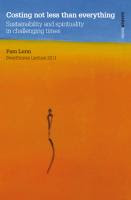This post comes from Tim Gee - a link to his regular blog is at the bottom of this post.
UK Floods: This changes everything.
This changes everything. Or at least it
should. Perhaps it should have done long before, when the hurricane hit Haiti,
or when a report revealed 400,000 people a year dying due to climate change, or
even when the first major UK campaign on climate change kicked off back in
1989. But we don’t live in the world as it should be. If we did, the floods wouldn't be happening in the way they are, and our climate would be
stabilising.
Nestled
behind the temporary safety of the Thames Barrier, my house didn't flood last
week. But reading the reports of the countryside underwater, my heart sank,
turning to anger at the pictures of politicians in wellington boots, trying
their best to look concerned in the midst of the problem they collectively
failed to solve and contributed to creating.
They
say that when you drown your life flashes before your eyes. It may well be
true, because even reading about the floods made 15 years of climate activism
flash before mine. From the first inklings of environmental consciousness on
the residents’ march against the second runway at Manchester Airport to the present
fight against fracking. Every struggle has been about facing down different
ills – noise, harm to nature, local pollution. But sitting above them all is
the recognition that more dirty infrastructure leads to more climate change,
which in turn leads to the kinds of extreme weather events we're beginning to
see now.
Of
course, the pedants can argue that it's difficult to prove that this flood here
was because of that pollution there. But that fact remains that the scientists
have consistently warned that more climate change will lead to more extreme
weather. It's a message we'll need to repeat again and again.
As
the memories keep flooding back, most of all I'm taken back to a conversation
with a stranger on a bus in Copenhagen on the final day of the 2009 climate
talks there. My arm in a sling - having been beaten by a police officer the
previous day – the stranger asked what we would do if the politicians failed to
stop climate change and the effects got worse. It wasn't a question I'd considered
before. I responded that we'd work for justice with the worst affected
communities, to stop the effects from hitting them so hard, and keep working to
stop the process of climate change intensifying. With the news this month - and
especially the many unreported tragedies outside of the wealthy South East - it
feels as though that time may now be up on us.
Like
me, my grandfather was a lifetime activist, although his work was principally
for peace. But when the world descended into war, he didn't just step aside. As
many other Quakers did, he joined the Friends Ambulance Unit, committing to
practical tending of casualties on the ground. Some pacifists were critical,
calling it a process of clearing up the mess rather than tackling the causes,
and even seeing it as counterproductive, as it involved liaising with various
armies. But the experience served to strengthen - rather than water down – his
pacifist convictions, and the project was a factor in the Quakers being awarded
the Nobel Peace Prize a few years later. Many commentators have called our
current crisis a world war moment. If it is, then those of us skeptical of
authoritarian solutions need to ask what a transformative response should be.
And
that's why this changes everything, not for the media and politicians who will
continue to focus on the concerns of the rich, but for us. It is clear that the
onset of climate change even further demonstrates need for a radically
different form of politics and economics, but it also suggests the need for us –
the activists – to ask ourselves some difficult questions about how we get
there:
Some
of us have learned how to work with our communities against site-based dirty
infrastructure, but how do we work differently when the effects are dispersed?
Some of us have learned how to block roads, but do we know how to unblock
drains? Some of us have suffered at the hands of the police, but can we reach
an understanding with the emergency services so that the maximum number of
people can be helped? And reflecting on the emotional distress that most people
encounter in the context of site-battles, how can we prepare ourselves inwardly
– even spiritually - for situations still more intense? And perhaps most
importantly of all, how can we work with people affected by extreme weather to
stand against the process of climate change which is magnifying the scale of
the weather events in the first place?
These
and more are questions we'll need to answer as a movement in the coming days
and weeks. No doubt the weather will drop from the headlines at some point, but
if the scientists are right - as they seem to have been so far – the climate
has already begun to change. Perhaps it is time for us to do so too.



